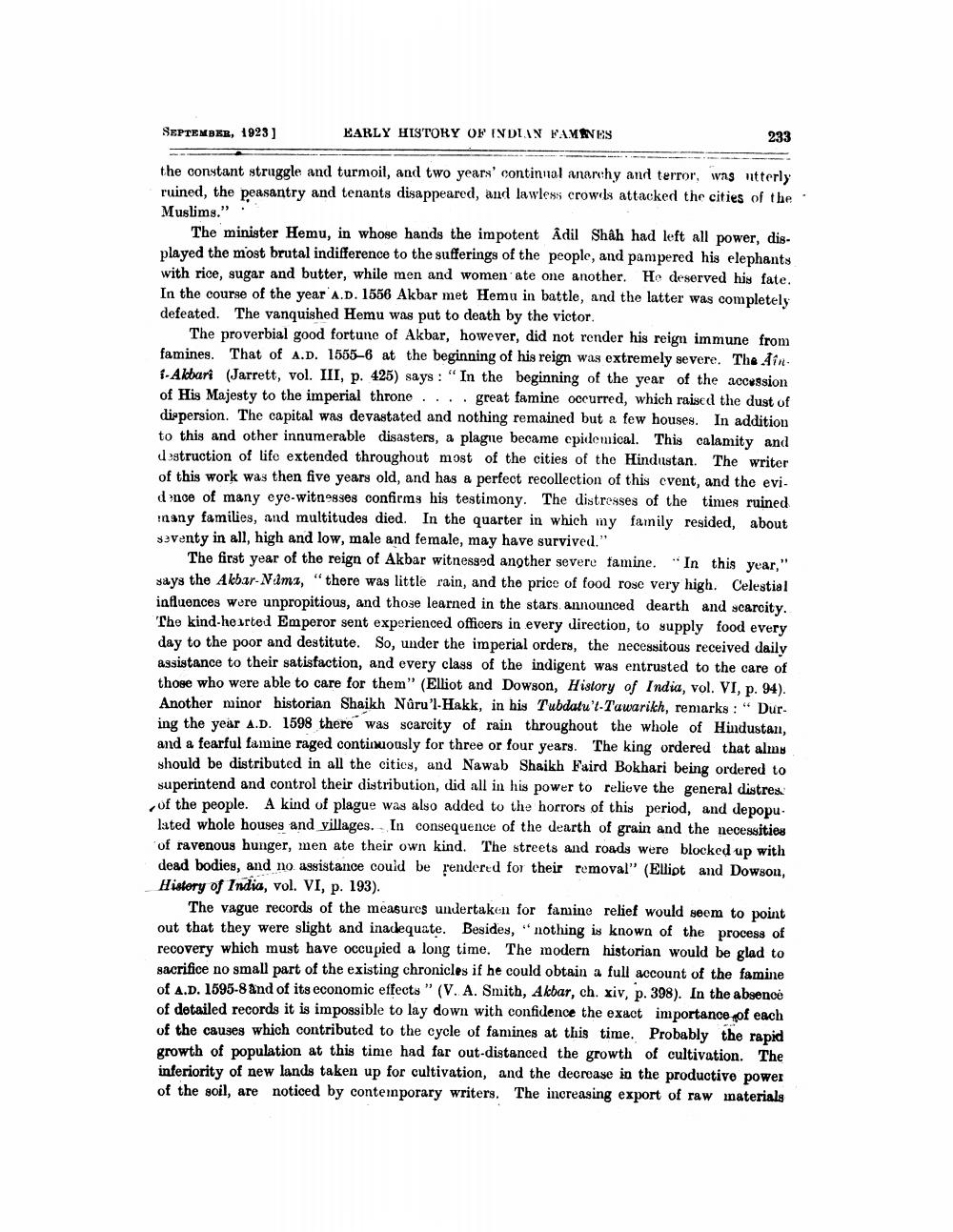________________
SEPTEMBER, 1923]
EARLY HISTORY OF INDIAN FAMINES
233
the constant struggle and turmoil, and two years' continual anarchy and terror, was ntterly ruined, the peasantry and tenants disappeared, and lawless crowds attacked the cities of the Muslims."
The minister Hemu, in whose hands the impotent Adil Shah had left all power, displayed the most brutal indifference to the sufferings of the people, and pampered his elephants with rice, sugar and butter, while men and women ate one another. He deserved his fate. In the course of the year A.D. 1556 Akbar met Hemu in battle, and the latter was completely defeated. The vanquished Hemu was put to death by the victor.
The proverbial good fortune of Akbar, however, did not render his reign immune from famines. That of A.D. 1565-6 at the beginning of his reign was extremely severe. The ini-Akbari (Jarrett, vol. III, p. 425) says: "In the beginning of the year of the accession of His Majesty to the imperial throne.... great famine occurred, which raised the dust of dispersion. The capital was devastated and nothing remained but a few houses. In addition to this and other innumerable disasters, a plague became epidemical. This calamity and destruction of life extended throughout most of the cities of the Hindustan. The writer of this work was then five years old, and has a perfect recollection of this cvent, and the evidence of many eye-witnesses confirms his testimony. The distresses of the times ruined
any families, and multitudes died. In the quarter in which my family resided, about seventy in all, high and low, male and female, may have survived."
The first year of the reign of Akbar witnessed another severe famine. "In this year," says the Akbar Namı, "there was little rain, and the price of food rose very high. Celestial influences were unpropitious, and those learned in the stars announced dearth and scarcity. The kind-hearted Emperor sent experienced officers in every direction, to supply food every day to the poor and destitute. So, under the imperial orders, the necessitous received daily assistance to their satisfaction, and every class of the indigent was entrusted to the care of those who were able to care for them” (Elliot and Dowson, History of India, vol. VI, p. 94). Another minor historian Shaikh Nûru'l-Hakk, in his Tubdatu'lTawarikh, remarks: " Dur. ing the year A.D. 1598 there was scarcity of rain throughout the whole of Hindustan, and a fearful famine raged continuously for three or four years. The king ordered that alms should be distributed in all the cities, and Nawab Shaikh Faird Bokhari being ordered to superintend and control their distribution, did all in his power to relieve the general distres of the people. A kind of plague was also added to the horrors of this period, and depopu. lated whole houses and villages. In consequence of the dearth of grain and the necessities of ravenous hunger, men ate their own kind. The streets and roads were blocked up with dead bodies, and no assistance could be rendered for their removal" (Ellipt and Dowson, History of India, Vol. VI, p. 193).
The vague records of the measures undertaken for famine relief would seem to point out that they were slight and inadequate. Besides, nothing is known of the process of recovery which must have occupied a long time. The modern historian would be glad to sacrifice no small part of the existing chronicles if he could obtain a full account of the famine of A.D. 1595-8 and of its economic effects" (V. A. Smith, Akbar, ch. xiv, p. 398). In the absence of detailed records it is impossible to lay down with confidence the exact importance of each of the causes which contributed to the cycle of famines at this time. Probably the rapid growth of population at this time had far out-distanced the growth of cultivation. The inferiority of new lands taken up for cultivation, and the decrease in the productive power of the soil, are noticed by contemporary writers. The increasing export of raw naterials




